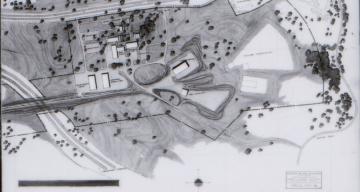Legacy SLACspeak S
S/C Sub Contract.
SAAC Scientific and Academic Advisory Committee.
SABER South Arc Beam Experimental Region.
SAC Science Advisory Committee.
SAD SLAC Advanced Design Committee (ca. 1968)
SAIC Science Applications International Corporation.
SAMMI SLC Automatic Magnet Measuring Instrument.
SAMPLE an experiment at MIT-Bates, measuring backward-angle electron scattering from hydrogen and deuterium targets.
SAN Department of Energy San Francisco Operations Office.
S-BAND Feedback A feedback system to lock the beam extraction time from Damping Ring to an S-BAND (LINAC RF) reference.
SBIR Small Business Innovation Research
SBSS Science-Based Stockpile Stewardship
SCA SuperConducting Acceleration. Also, SuperConducting Accelerator (Stanford University).
SCC Serial Crate Controller. A camac module driving an individual crate and used to interface between the serial link multibus and the CAMAC modules in that crate.
SCIP Stanford Center for Information Processing.
SCP SLC Control Program (Pronounced SKIP). The process running the COWs and other consoles when they are controlling the SLC machine. Each console can be operated under its own SCP program.
SDC Solenoidal Detector Collaboration (SSC)
SDI Strategic Defense Initiative.
SDR South Damping Ring.
SDS Status Display Summary. An MCC display that shows the operational status of various SLC devices.
SEAB Secretary of Energy Advisory Board (DOE).
Secondary A class of subsignal names in the VAX SLC database. Each primary signal can have up to 255 secondaries or subsignals.
SEP SSRL Enhancement Project
SERC Science and Engineering Research Council.
SETL A magnet parameter indicating the settling time for a power supply to stabilize after a change. A SLC VAX secondary.
SFT Super Fixed Target beauty Facility. Competing with other B factory ideas, SFT proposed using a 20Tev proton beam to measure CP violation at the SSC Laboratory. The SFT proposal was turned down in review.
SHAP Supplemental Housing Allowance Program.
SHB SubHarmonic Buncher. The bunching system after the CID gun that groups the electrons into the two bunches needed by SLC. The two SHB (178.5 MHz) are subharmonics (1/16 of S-Band) of the LINAC RF frequency. It incorporates the following: A) A magnetic mirror to protect the gun, B) Ten solenoids to maintain the beam through the pipe and inhibit the spiraling of the electrons, C) two subharmonic bunchers in which the bunching is accomplished through velocity modulation using a standing wave resonator and two cavities.
SHF SLAC Hybrid Facility photon collaboration.
SII SLAC Improvement Initiative.
Simple Timing Buffer See STB.
SIP Summary Information Process. A database primary.
SIPRI Stockholm international Peace Research Institute.
SISE Summer Internships in Science and Engineering. See ERULFs.
SITN Stanford Instructional Television Network. Operated through the Stanford Center for Professional Development (SCPD). SCPD broadcasted over 250 Stanford courses a year.
SLAC-LBL detector Original name of the Mark I detector. One of the first large solid angle detectors. Built by SLAC Group E (Martin Perl and Gary Feldman), Group C, and a Lawrence Berkeley Lab group led by Willy Chinowsky, Gerson Goldhaber, and George Trilling. Detector was later expanded to improve muon detection and then modified to improve the electron and photon detection.
SLAM SLC LAM Generator. A CAMAC module.
SLC Stanford Linear Collider (100 GeV Ecm). Originally SLAC Linear Collider.
SLC Control Program See SCP.
SLC Large Detector See SLD.
SLCCS SLC Control System. Software system designed in the early 1980's for accelerator control.
SLCNET The broadband local area digital network that communicates between the VAX and the micros located in the various SLC areas. This is a custom high speed logic star network using MULTIBUS.
SLD SLAC Large Detector. A particle physics detector optimized for the SLC interaction point. SLD has also been called the Stanford Large Detector and the SLC Large Detector. Sources close to the experiment confide that SLD was originally called the Slick Little Detector.
SLD-Notes Publication produced by the SLD Collaboration on an irregular basis.
SLEAP Stanford Linear Electron Accelerator Project. (1960's name for what eventually became SLAC. Came after Project M name.)
SMC Stepper Motor Controller. A CAMAC module.
SMP Strategic Military Panel
SMPS SMall Power Supply. A SLC VAX primary.
SNOOP Diagnostic module for Fastbus.
SOB StandOff Box. (BaBar)
SOPF Stanford Outdoor Primate Facility
South Injection Tunnel See SIT.
SPASM Single-Pass ASseMbler.
SPC Single Pass Collider.
SPCP Single Pass Collider Project (Proposed in 1980).
SPI Sign of Polarization Inverter, a SLC Polarized Light Source Subsystem.
SPIRES Stanford Public Information REtrieval System. A database management system widely used for large bibliographic databases. At SLAC, BINLIST, HEP, BOOKS, DRAW, CONF, SEMINARS, SERIALS, and INST are some of the databases maintained in SPIRES.
SPRK Spark chamber.
SRC Science Research Council.
SSC Superconducting Super Collider (defunct).
SSC Advisory Panel See SSCAP.
SSCAP The SSC Advisory Panel. An international committee of physicists that determined the SSC experimental program.
SSP Science Simulation Plan
Stanford Public Information Retrieval System See SPIRES.
STANFORD-PRINCETON STORAGE RINGS A figure-eight, weak-focusing, electron-electron collider built at Stanford in 1958-1963 by a group led by Gerald K. O'Neill (Princeton) and Burton Richter (Stanford). Using the Stanford MARK III accelerator as an injector, the collider consisted of two rings, each ten feet in diameter, in which electrons circulated in opposite directions, colliding at the intersection point. When built, the rings contained the largest ultra-high vacuum system in the world. The energy lost to synchrotron radiation was compensated for by a radio frequency system which gave an electron a boost of energy as it came through the accelerating cavity. The detector used on the rings was an optical spark chamber.
STEP A SLC VAX primary which includes stepping motor status and other devices using such motors.
STRC STReamer Chamber.
Summary Information Process See SIP.
SUP Seismic UPgrade.
SuperB A high-intensity B-factory planned for construction near Frascati in Italy
Supersloop Working name for 1970's project to convert the SLAC linac to a superconducting accelerator. (Project was canceled)
SUPF Stanford University Primate Facility (former SLAC neighbor).
System 20 Box A local network server used by the VAX computers to communicate with their terminals. System 20 uses one frequency band of the CATV network. The box is made by SYTEK.

